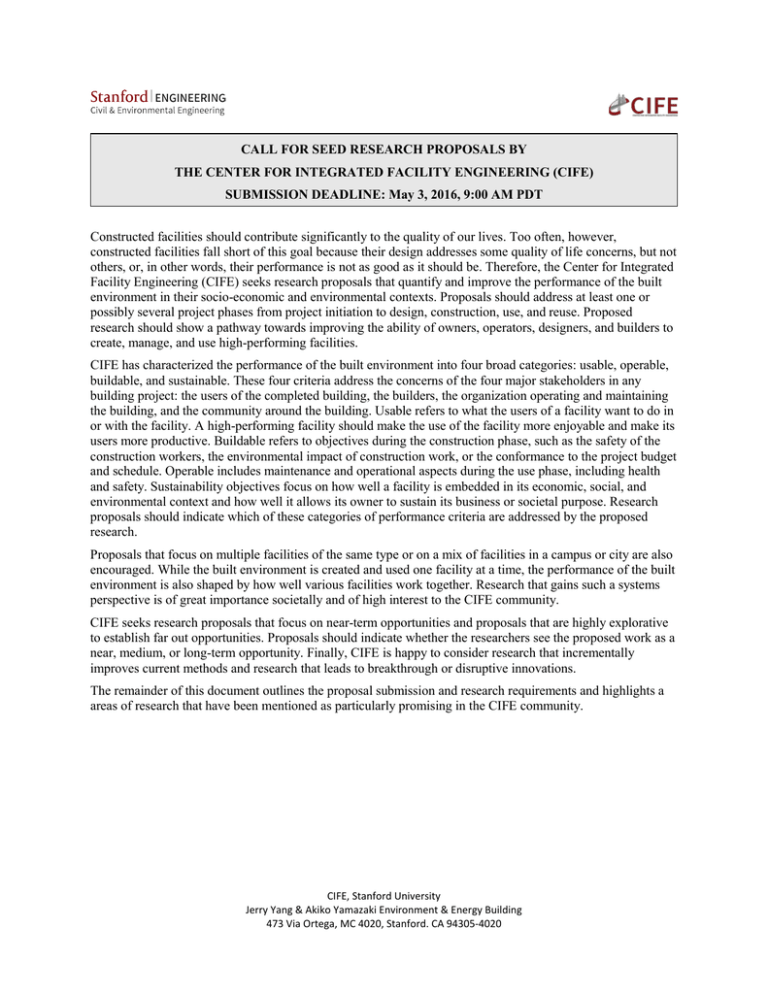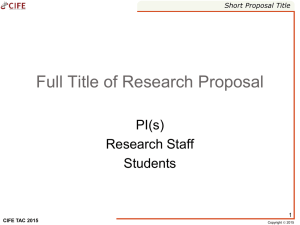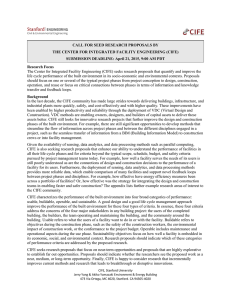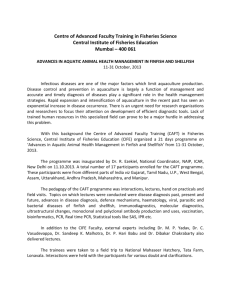Document 14084178
advertisement

CALL FOR SEED RESEARCH PROPOSALS BY THE CENTER FOR INTEGRATED FACILITY ENGINEERING (CIFE) SUBMISSION DEADLINE: May 3, 2016, 9:00 AM PDT Constructed facilities should contribute significantly to the quality of our lives. Too often, however, constructed facilities fall short of this goal because their design addresses some quality of life concerns, but not others, or, in other words, their performance is not as good as it should be. Therefore, the Center for Integrated Facility Engineering (CIFE) seeks research proposals that quantify and improve the performance of the built environment in their socio-economic and environmental contexts. Proposals should address at least one or possibly several project phases from project initiation to design, construction, use, and reuse. Proposed research should show a pathway towards improving the ability of owners, operators, designers, and builders to create, manage, and use high-performing facilities. CIFE has characterized the performance of the built environment into four broad categories: usable, operable, buildable, and sustainable. These four criteria address the concerns of the four major stakeholders in any building project: the users of the completed building, the builders, the organization operating and maintaining the building, and the community around the building. Usable refers to what the users of a facility want to do in or with the facility. A high-performing facility should make the use of the facility more enjoyable and make its users more productive. Buildable refers to objectives during the construction phase, such as the safety of the construction workers, the environmental impact of construction work, or the conformance to the project budget and schedule. Operable includes maintenance and operational aspects during the use phase, including health and safety. Sustainability objectives focus on how well a facility is embedded in its economic, social, and environmental context and how well it allows its owner to sustain its business or societal purpose. Research proposals should indicate which of these categories of performance criteria are addressed by the proposed research. Proposals that focus on multiple facilities of the same type or on a mix of facilities in a campus or city are also encouraged. While the built environment is created and used one facility at a time, the performance of the built environment is also shaped by how well various facilities work together. Research that gains such a systems perspective is of great importance societally and of high interest to the CIFE community. CIFE seeks research proposals that focus on near-term opportunities and proposals that are highly explorative to establish far out opportunities. Proposals should indicate whether the researchers see the proposed work as a near, medium, or long-term opportunity. Finally, CIFE is happy to consider research that incrementally improves current methods and research that leads to breakthrough or disruptive innovations. The remainder of this document outlines the proposal submission and research requirements and highlights a areas of research that have been mentioned as particularly promising in the CIFE community. CIFE, Stanford University Jerry Yang & Akiko Yamazaki Environment & Energy Building 473 Via Ortega, MC 4020, Stanford. CA 94305-4020 Timetable and requirements for projects for funding during AY 2016-17 March 23 April 26 May 3 9:00 AM PDT Call for proposals available to the Stanford and CIFE communities. Request the budget for your proposal from Engineering Research Administration for departments in the School of Engineering or your local research administration staff for other Stanford departments. Note that the majority of the requested funding should normally be allocated to research students. Request a proposal number from Teddie Guenzer at CIFE (cife-email@stanford.edu). Submit your proposal in .doc, .docx, or .pdf format including the budget to cifeemail@stanford.edu. Use the proposal template; also available at: http://cife.stanford.edu/SeedProposals2016. May 5 9:00 AM PDT May 10 May 17 July 1 Oct. 1 Jan. 1, 2017 Note: Note: Sept. 30, 2017 Oct. 31, 2017 Submit the slides you plan to use for the presentation at the Technical Advisory Committee (TAC) meeting in .ppt or .pptx format to cife-email@stanford.edu. Use the template; also available at: http://cife.stanford.edu/SeedProposals2016. Present your proposal to CIFE’s industrial members at the TAC meeting. The proposals will be evaluated with this review form; also available at: http://cife.stanford.edu/SeedProposals2016. CIFE award decisions announced. Earliest start date for the proposed research. Typical start date. Latest start date to start research. At the requested funding time, CIFE will establish a skeleton project website which should then be completed by the research team 1. Continued funding for the second half of the project is contingent on updates to the website in accordance with the milestones listed in the proposal. Throughout AY 2016/17, PI(s) and RA(s) on funded seed projects are expected to be available occasionally to present the research at CIFE seminars and workshops or to visiting academics or industry professionals. Latest date for research completion unless a no-cost extension was requested. Submit final project report to CIFE for publication as a Technical Report, Working Paper, video, or website. Follow the guidelines for authors available on the CIFE website. Funding Levels There are no fixed funding limits for proposals. Since these are seed projects, typical project budgets range from $30,000 to $90,000. We encourage multi-PI proposals and are looking for proposals that leverage CIFE’s industrial members. We also encourage innovative arrangements among PIs, such as multiple PIs proposing a number of research projects that focus on the same test case(s) in complementary ways. The total amount of funds available for seed projects this year is at least $300,000. Because of budgetary constraints, successful proposals may not be awarded all of the funds requested. If the Technical Advisory Committee suggests a reduced budget for a project, an adjusted scope will be discussed with the PI(s). Intellectual Property Rights The research carried out through the CIFE Seed Research program is, of course, governed by the research and intellectual property guidelines and rules in effect at Stanford University. 1 The website should provide access to at least the following information: (1) A practical scenario illustrating the engineering or business problem addressed by the research and highlighting the potential impact of the research on practice, (2) the original proposal (except the budget), (3) explanations of test cases used for the project, and (4) presentations developed for this project. 2 Appendix: Examples of research areas mentioned by members of the CIFE community Topics of particular interest from the CIFE community mentioned at the Industry Advisory Board (IAB) include understanding facility performance, optimization, automation, and new work processes, business models, or potentially a new operating system for the construction industry. The availability of sensing, data analytics, and data processing methods such as parallel computing is rapidly enhancing our ability to understand the performance of facilities in all their life cycle phases and for criteria beyond the typical scope, schedule, budget, and safety criteria pursued by project management teams today. However, how well a facility serves the needs of its users is still poorly understood as are the connections of design and construction decisions to the performance of a facility for its users. Furthermore, the deployment of sensing, data analytics, and data processing methods provides more reliable data, which enable comparison of many facilities and support novel feedback loops between project phases and disciplines. Research with an optimization focus should address one or several of the main facility performance objectives and could – among other topics – formalize improvements in the number of objectives covered, problem formulation and structuring, human-computer interaction, and engineering and decision processes. For example, the fragmented discipline-specific knowledge required for addressing the many performance objectives of the unique projects in the construction industry makes the formulation of optimization problems and their structuring to enable rapid calculation on many nodes challenging. The many types of algorithms and variables used to predict the performance of a facility with respect to the various performance objectives creates a further challenge for more widespread use of optimization methods. Furthermore, human-computer interfaces still focus essentially on single-tool, single-user perspectives; such a perspective is insufficient for the deployment of optimization techniques in project teams. Finally, being, for example, able to develop the best structural design or the best schedule rapidly allows us to reimagine engineering and decision-making workflows and processes and the corresponding business models. The IAB also highlighted increasing automation in the design, construction, and operation of facilities as a promising area of research. Examples of automation include automating multi-disciplinary design analysis, generation of design details, comparison and benchmarking of design solutions, construction planning and management, transfer of information between disciplines and phases, e.g., from design to fabrication or from construction to facility management, and inspection of digital information or (partially) built structures, etc. These improved technologies and engineering methods allow us to imagine more efficient and effective work processes that, in turn, enable different business models and a modern operating system for the construction and real estate industry. The value of built assets is directly affected by the myriad decisions made in a continuous process of “designing > engineering > bidding > financing > leasing > refinancing > adapting > re-leasing > selling” constructed facilities. With ubiquitous information systems recording and optimizing decisions, decision makers are moving from their professional silos and guilds to embrace the need for a shared language and layer of interoperability. Facts, engineering considerations, use requirements, contractual and legal agreements, and financial analysis developed by one guild of decision makers, if recorded in an interoperable form for reuse, would save time, increase value, and reduce uncertainty, delay, and costs in adapting existing and future buildings, infrastructure, urban environments. Hence, new ways to design, engineer, build, and lease constructed facilities are needed to include the whole ecosystem of stakeholders, from facility users and operators to design and construction professionals and real estate lenders and investors. Such a better informed process should, for example, reward decisions to save energy, improve adaptability, or respect community environmental and social concerns with better interest and cap rates because these more sustainable projects will be less risky investments. The research question is how to reach such a truly interoperable and sustainable way of creating and using the built environment. Researchers are, of course, not limited to the topics listed in this appendix. They are welcome to propose research with any focus on the broad objective outlined at the start of this call for proposals. 3


